
- Topics 1527
- Industrial 59
- Troubleshooting Guides 31
- Restaurant Management 140
- Bar Management 66
- Catering Tips 38
- Bakery Management 47
- Food Trucks & Concessions 47
- Advertising & Marketing 40
- Eco-Friendly Tips 12
- Facility Layout & Design 50
- Coffee Shop Tips 31
- Installation & Maintenance 59
- Janitorial & Pest Control 33
- Safety & Sanitation 109
- Startup Tips 113
- Menu Design 11
- Kitchen & Cooking Tips 103
- Hospitality Management 24
- Pizza & Sandwich Shop Tips 30
- Smallwares 40
- Food Prep 101
- Tabletop Items 19
- Disposables 26
- Calculators & Tools 8
- Consumables 70
- Warewashing & Laundry 21
- Cooking Equipment 101
- Food Storage & Refrigeration 54
- Beverage Equipment 39
- Office Supplies 5
One of the most enjoyable parts of summer is taking advantage of the warm weather and cooking outside. Grilling burgers, smoking ribs, or even cooking eggs on an outdoor griddle allows you and your guests to enjoy the great weather and a delicious meal simultaneously. Whether you're looking to make some new additions to your outdoor dining space or spicing things up with a new outdoor kitchen, look no further. Our commercial outdoor cooking equipment buying guide will help you find what you need to start making all your favorite summertime staples.
Shop All Outdoor Cooking Equipment
Use the following links to learn about types of outdoor cooking equipment:
Outdoor grills are a staple of every outdoor kitchen, capable of cooking meats and vegetables to perfection. From juicy burgers with distinctive sear lines to Argentinian barbeque, grilled food is the centerpiece of summer menus, catering events, and tailgating. When purchasing an outdoor grill, choose from a variety of sizes, fuel types, and transportation capabilities. Consider our guide to different types of charcoal and wood for the best grilling flavor.
Familiarize yourself with the different options for outdoor grills below, and check out our in-depth guide on outdoor grills for more information.
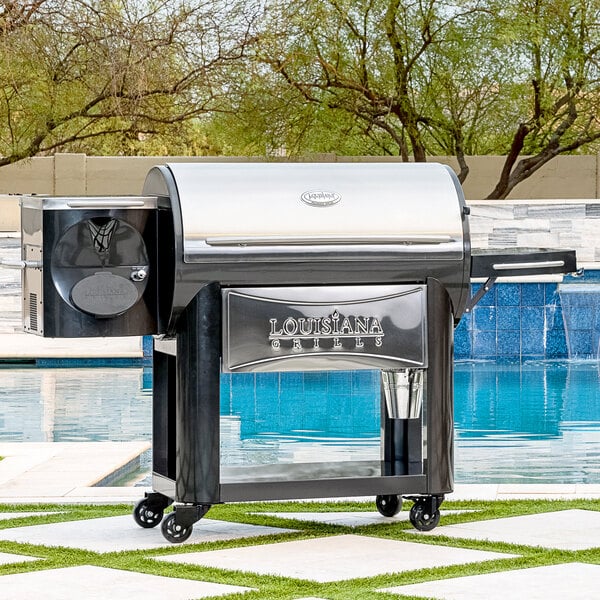

Outdoor Pellet Grill
Pellet grills are a perfect choice if you want to capture the unique, smoky flavors of outdoor grilling. They utilize wood pellets as fuel, which are burned in the fire pot while a fan system disperses the heat and smoke into the cooking chamber. Unlike charcoal grills, this method allows for temperature regulation. It also keeps the smokey flavor that gas grills lack.
- Can smoke, bake, grill, or braise food
- Options to cook low and slow or hot and fast
- Option to set the grill at a specific temperature
- No open flame, so no fear of flare-ups
- Difficult to clean
- Expensive
- Require more prep than gas grills
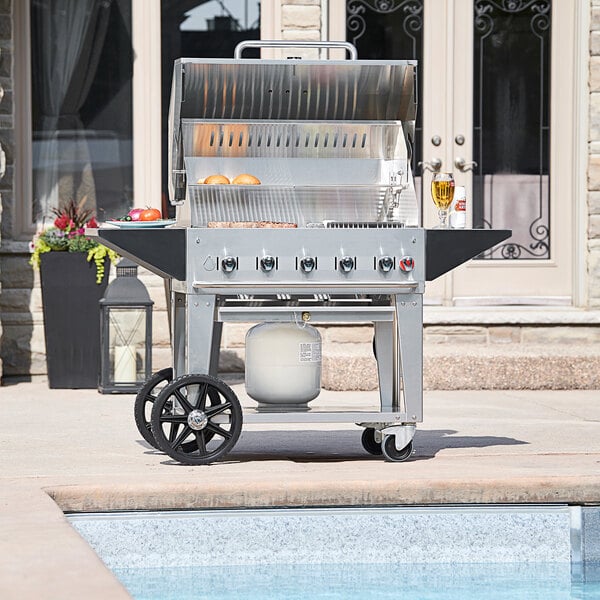

Outdoor Gas Grills
Gas grills tend to be the most popular grill type among amateur and professional chefs due to their convenience. Gas grills are known for reaching optimum cooking temperature quickly. Their temperature control knobs allow for precise control of the heat. However, they require regular maintenance of their valves, burners, and vents, and they fail to produce the smoke flavor characteristic of grilled foods.
- Reaches optimum cooking temperature in 10-15 minutes
- Evenly distribute heat across the cooking surface
- Temperature control knobs allow you to create heat zones for different types of cooking
- Fuel tank is easy to refill
- Requires little cleanup
- No smoke flavor because of gas power
- Regular maintenance of the mechanisms required
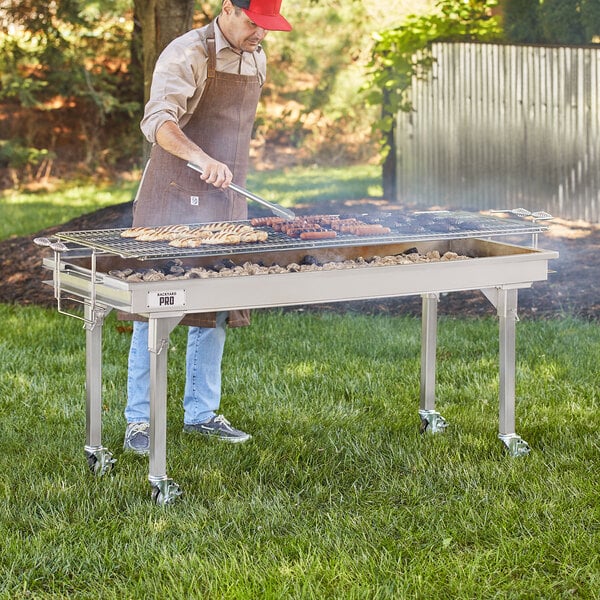

Outdoor Charcoal Grills
Charcoal grills are the traditional option for people who love the grilling process and the delicious, smoky flavor of grilled foods. Multiple grill shapes utilize charcoal for fuel, including kettle grills, barrel grills, and kamado grills, with different intended purposes for grilling. Cooking on a charcoal grill requires more time, attention, and effort during the grilling process and cleaning up after dinner.
- Reaches high temperatures of up to 700 degrees Fahrenheit
- Provides a smoky, rich flavor associated with outdoor grilling
- Takes 20-30 minutes to heat to cooking temperature
- No control knobs to regulate temperature
- Cleaning the ash and leftover charcoal from the grill is time-consuming
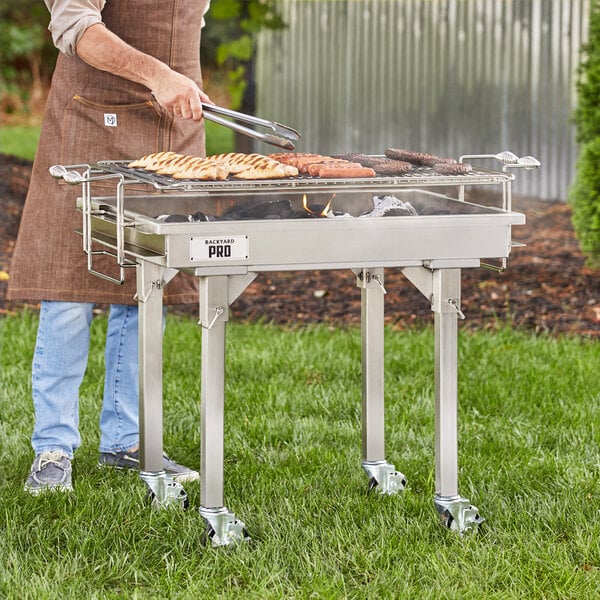

Portable Grills
Investing in portable grills is a smart move for businesses that only grill during certain seasons. Portable grills are equipped with casters, which make them much easier to transport. Some grills have removable legs that make them easy to store. Other grills even come with slide-action grates that you can adjust to different heights for optimal control over cooking temperatures.
If you are looking for an easy-to-transport grill, consider purchasing a towable grill. These grills are attached to trailers that you can hook up to your vehicle and pull behind you, making them some of the best outdoor grills for caterers or tailgating events.
- Easy to transport and store
- Multiple sizes available, including tabletop options
- Less expensive
- Easy to protect from poor weather conditions or other hazards
- Less durable, requires frequent replacement
- Smaller size produces lower food quantities
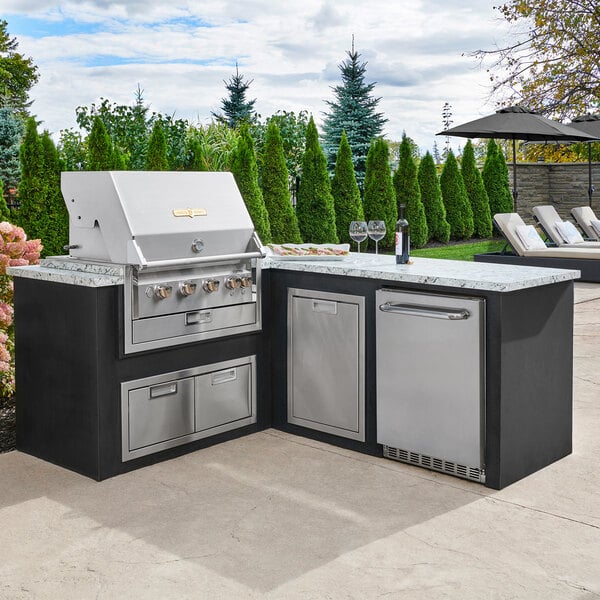

Built-in Grills
For a more permanent solution to your grilling needs, consider investing in a built-in grill on your deck or patio, especially if you plan to use the area in the winter. Built-in grills often boast higher power capabilities, making grilling for many customers at once easy.
Built-in outdoor grills come in various durable constructions, like stainless steel, that allow them to withstand the elements. With natural gas and liquid propane options, restaurateurs can customize their units to best fit their needs. For an upgrade, consider adding a rotisserie attachment or smoker box to your built-in grill and expand your menu offerings.
- Permanent structure designed to match the rest of your outdoor kitchen
- Better customized to your needs
- Long-lasting
- Expensive
- Immobile once installed
- Requires additional permits to install
Outdoor Grill Accessories
No grill is complete without the addition of several outdoor grill accessories. These tools help you take grilling to the next level by giving you more space, more control over the food, and more ways to keep your grill functioning at peak capacity.
- Skewers: Grilling skewers hold food together during grilling and can be used on steak, chicken, and vegetables to make delicious shish kebobs.
- Grill covers: Use a grill cover to protect your outdoor grill from the elements, such as rain, snow, falling leaves, and dirt.
- Dome lids: Add a dome lid to your grill to protect the cooking surface and get the signature sear marks on steak or chicken.
- Grill thermometers: For easy temperature monitoring, mount a grill thermometer inside your grill.
- Marinade injectors: A marinade injector allows you to inject marinades directly into your meats to enhance their tenderness and flavor.
- Basting brushes: Use a basting brush to spread liquid marinades on top of meats before and while you grill to produce a delicious final product.
- Side shelves: Installing grill side shelves increases your workspace, allowing you to keep ingredients close and plate food right at the grill.
- Grill side burners: By adding grill side burners, you can saute different dishes while you grill or keep sauces and finished products hot.
- Grill splash guards: A grill splash guard helps protect you and your surroundings from hot splatters while maintaining product visibility.
Consider Outdoor Grill Production Levels
Outdoor grills have different levels of production based on their size, fuel type, and the number of burners. As you consider adding a grill to your outdoor space, know its production capabilities compared to the amount of food you plan to serve. Below are the levels of production for different types of grills.
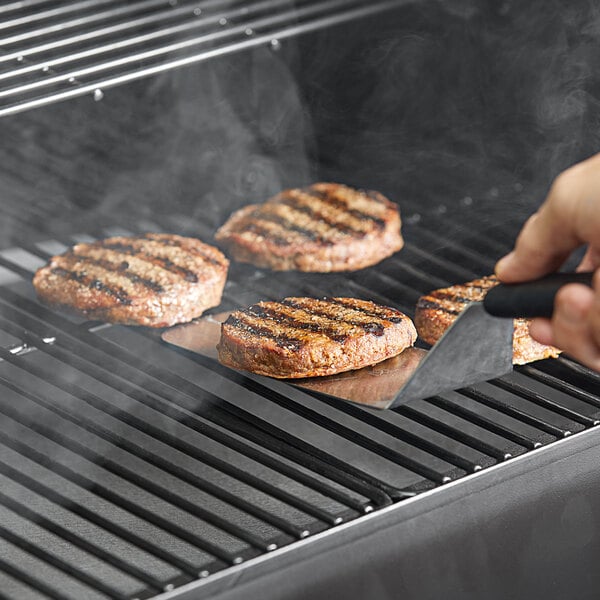
- Low production: Low-production grills have between one and five burners, a 45,000 - 180,000 BTU range, and 19" - 74" cooking surface width. They're powered by charcoal, propane, or natural gas and are ideal for small catered events.
- Medium production: Medium-production grills have between two and eight burners, a 49,000 - 180,000 BTU range, and 54" - 76" cooking surface width. They’re powered by charcoal, propane, or natural gas and are ideal for mid-size catered events.
- High production: High-production grills have between six and ten burners, a 99,000 - 160,000 BTU range, and 56" - 81" cooking surface width. They’re powered by charcoal, propane, or natural gas and are ideal for large catered events.
Whether you choose an iconic wood-fired oven or a practical propane option, outdoor pizza ovens are a unique addition to your outdoor kitchen. They allow you to bake and serve authentic, Italian-style pizza with a classic wood-fired taste. However, pizza ovens are versatile and are great for cooking roasted vegetables, slow-cooked meats, potatoes, fresh loaves of bread, casseroles, and more.
There are many sizes, styles, and capacity options for outdoor pizza ovens. While some only hold one pizza at a time, others offer high-volume production. No matter the size, cooking times are relatively fast once the oven is at the correct temperature. You can finish baking an entire pizza in less than five minutes, allowing you to serve many people in a short timeframe.
Outdoor Pizza Oven Accessories: Consider getting a pizza peel or a pizza stone to help take your pizza to the next level.
Outdoor Pizza Oven Fuel: Propane, natural gas, or wood
Choose between built-in and mobile outdoor pizza ovens. Your choice is determined by the type of operation you're running. If you have a restaurant with a patio or a wine garden, a built-in pizza oven is worth the investment. Caterers require portable options.
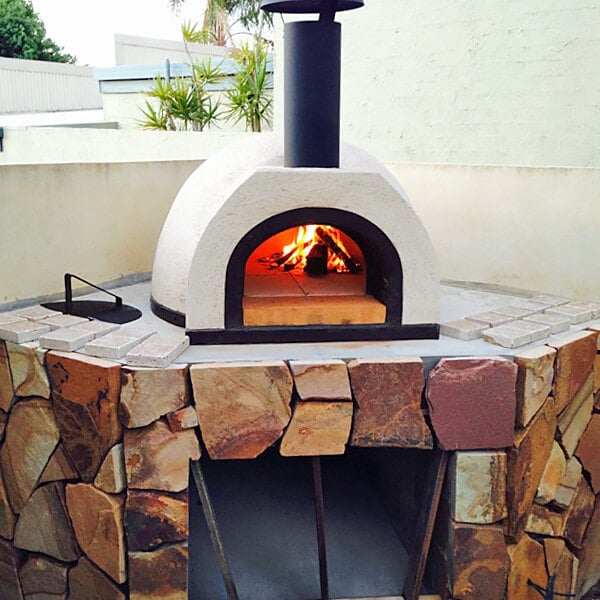

Built-In Outdoor Pizza Oven
Restaurants and catered event centers use built-in brick ovens both for function and for their presentation. They are aesthetically pleasing and have a larger capacity than portable outdoor pizza ovens. However, they are more expensive and fixed in one place. Since they're custom-made, their costs vary by size and the materials used to construct them.
- Higher capacity than portable alternative
- Aesthetically pleasing
- Serves as a patio or wine garden centerpiece
- Retains heat once hot
- Expensive
- Fixed location
- Take a long time to heat up
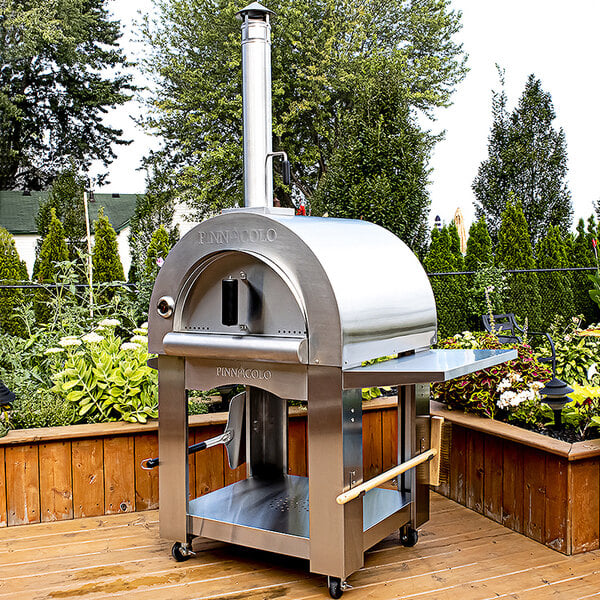

Mobile Outdoor Pizza Oven
While less traditional, a mobile pizza oven can be moved around your business or can travel with you, allowing you to serve pizza at outdoor catering events. They heat up and are ready to use faster than built-in pizza ovens, and tend to cook pizzas quickly. However, since many mobile pizza ovens are smaller, they can make high-volume production challenging.
- Travels easily
- Cooks quickly
- Less expensive than built-in outdoor pizza ovens
- Often has a reduced capacity
- Less aesthetically pleasing
Outdoor griddles are the most versatile outdoor cooking equipment on the market, able to grill, steam, saute, and fry food. You can cook various meals on them, including eggs for breakfast and an entire hibachi-style meal for dinner. Its large cooking surface allows you to make a lot of food at once.
Using an outdoor griddle comes with a lot of benefits beyond its versatility. Regardless of your cooking capabilities, this equipment accommodates nearly any food or level of experience.
- Easy to clean; some griddles even have a hole or trench for cooking debris.
- Less marinade, oil, and spices are needed because it remains on the cooking surface.
- Precise temperature control, including having different parts of the surface be at different temperatures.
- Accommodates small food items, such as shrimp, rice, diced vegetables, eggs, and more.
- Heats quickly without any open flames
Outdoor griddles come with many different production capabilities. Whether it offers 2 burners or 10, burners you can classify any outdoor grill by its fuel type. Discover the pros and cons of liquid propane outdoor griddles vs. natural gas outdoor griddles below.
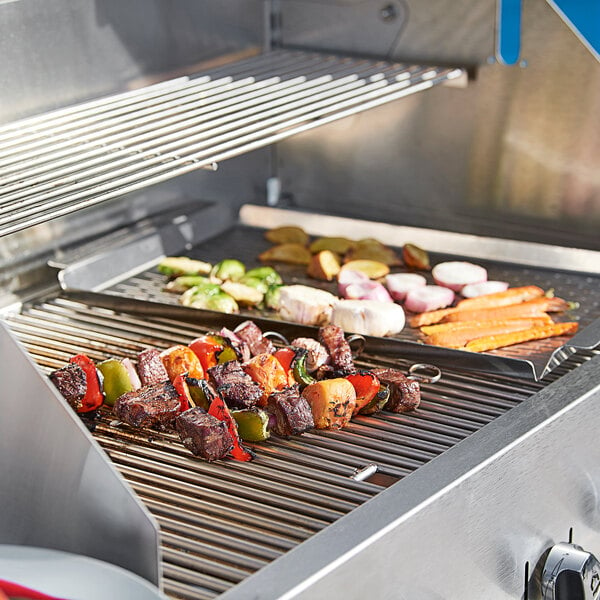

Natural Gas Outdoor Griddles
Natural gas outdoor griddles are perfect for event spaces and patios that have access to a natural gas supply line. We explain the benefits and disadvantages of purchasing and grilling with a natural gas griddle.
- Saves money long-term on propane costs
- Releases fewer fumes
- Greener choice
- Requires a natural gas connection
- Higher initial cost
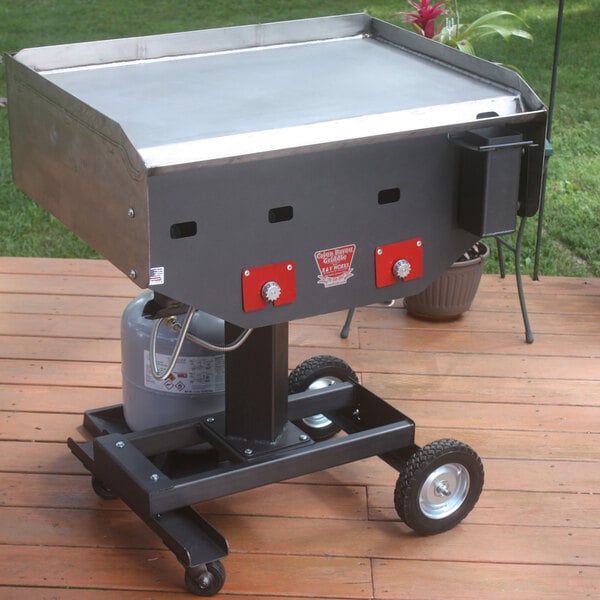

Liquid Propane Outdoor Griddles
Liquid propane outdoor griddles connect to standard portable propane tanks, making them a versatile, portable option. You can bring a propane tank with you to any outdoor catered event and cook with your griddle without needing a power connection point. Simply transport your griddle and propane to your event, and you can prepare food for guests.
- Can cook foods without a power connection
- Low carbon emission rate
- Cooks food at very high temperatures
- Propane must be handled with care
- Must make sure you stock enough propane for the unit to operate
- Additional costs of purchasing propane tanks
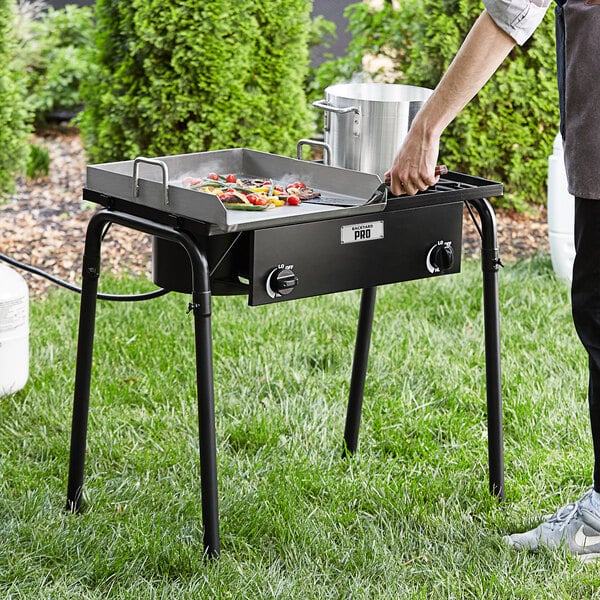
Outdoor Griddle Features
Many outdoor griddles have built-in side shelves, allowing you to keep ingredients close at hand or plate finished food. While built-in outdoor griddles are an option, you can choose a portable griddle with casters. These are great for off-site catering events or pop-up barbecues.
Production: Choose how many burners you need depending on the food quantity you cook. A griddle with one to five burners is perfect for personal use or small catering events, while eight to ten burners allow you to handle large catering events. Additionally, more burners allow you to heat parts of the griddle to accommodate different foods.
Fuel: Propane or natural gas
Other features: Consider purchasing an outdoor griddle with a dome cover. This helps protect the cooking surface and food while cooking and protects you from accidental burns. You can also get a wind guard to prevent food from blowing off the griddle.
Outdoor smokers are a popular choice for outdoor cooking equipment. However, many beginners fail to realize there are two kinds of equipment used to smoke meat. While smoker grills are versatile, smokehouses are designed specifically for smoking meats.
Fuel: Propane, electric, or charcoal
Other features: An express smoker is a good option if you need a fast turnaround; it can do a 5 lb. rack of ribs in one hour instead of seven.
You can broadly categorize outdoor smokers into two types: smoker and grill combo units and smokehouses. We break down the pros and cons of each style below.
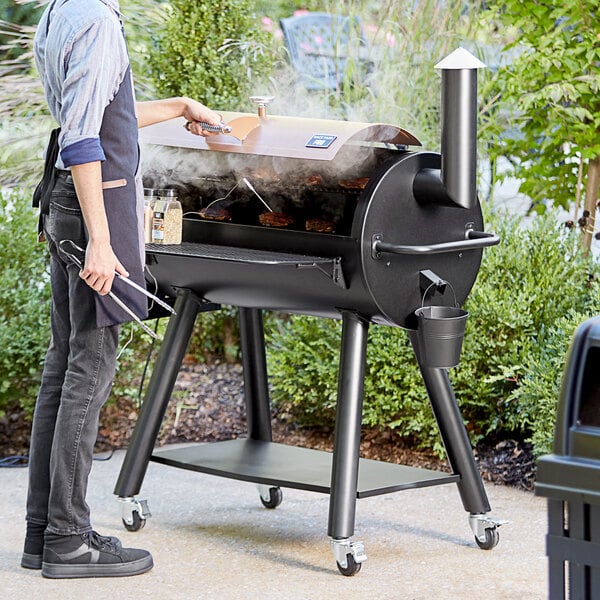

Outdoor Smoker Grills
Smoker grills can grill and smoke meat, making them versatile cooking equipment. They're ideal if you will spend most of your time grilling but want to do some smoking on the side too. A smoker grill or small smoker cabinet will work for most users who want to make some smoked meats.
- Versatile cooking options
- Easier temperature control
- Less powerful smoke flavor
- Not as effective for larger cuts of smoked meat
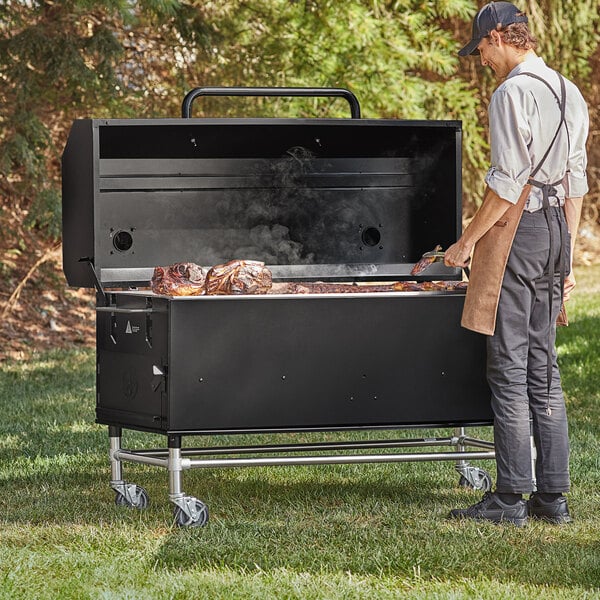

Outdoor Smoker
If you smoke meat frequently, an outdoor smokehouse is well worth the investment. They give you more control over your finished product. In larger units, you can hang sausages, fish, and other meats on hooks.
- More control over the finished product
- Ideal for large cuts of meat
- Imparts deep smoky flavors
- Extended cook times
- Require more skill to operate
- Less versatile than smoker/grill units
When buying an outdoor fryer, production is your biggest consideration. Many fryers list how many people they can feed each hour. Choose something that meets your current needs but gives you a little room to grow if you're planning on frying for larger events, like frying turkeys for a Thanksgiving feast.
- 4 gallons and under: Low production; tailgating events, picnics, small catered events.
- 6 gallon - 8 gallons: Medium-high production; small to mid-size catered events, concessions.
- 12 gallon and above: High production; fairs, large catered events, BBQ competitions.
When choosing an outdoor deep fryer, you can select a fryer unit or a steamer/fryer kit. Explore these options below.
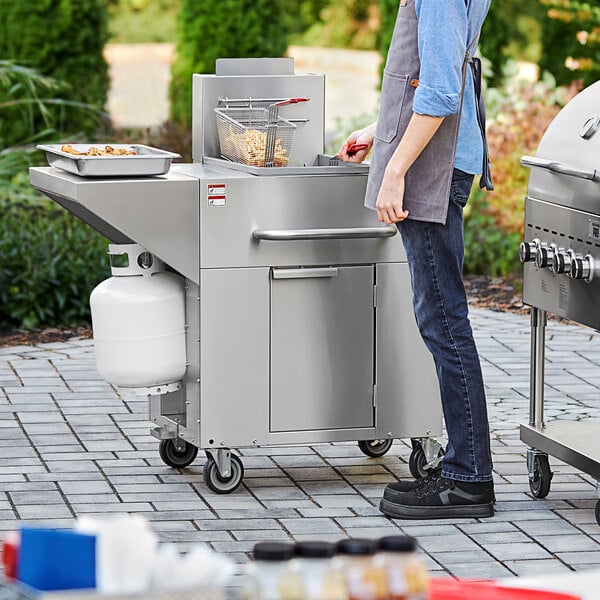

Outdoor Deep Fryers
Offer fried foods at your poolside restaurant, beach bar, or event venue with outdoor deep fryers. There are numerous portable options, allowing you to serve freshly fried food anywhere. These powerful units are capable of high-volume production.
- Mobile and portable options
- High-volume production
- Less versatile than combo units


Outdoor Fryer Steamer Kits
Outdoor fryer steamer kits allow you to tackle all your outdoor steaming and frying needs with one unit. Whether you need to fry a turkey, boil seafood, or make crispy French fries, these versatile units can do it all. In exchange for greater versatility, you'll trade the high production volumes of units dedicated solely to outdoor frying.
- Versatile
- Portable and mobile options
- Reduced volume compared to frying dedicated units
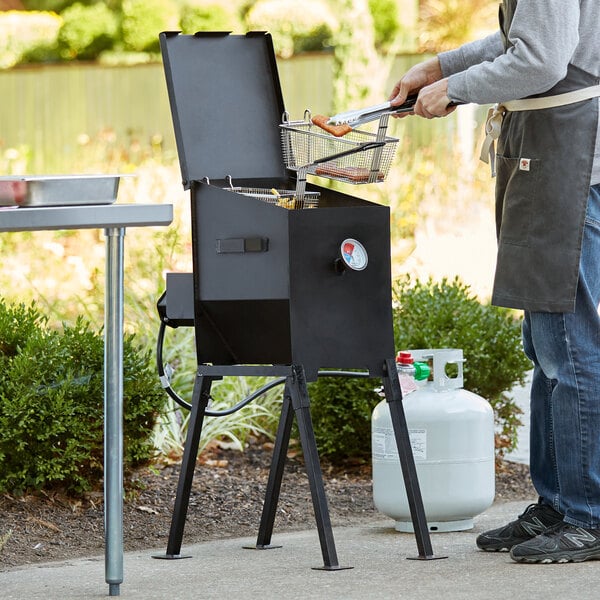
Outdoor Fryer Features
Consider your production needs and choose an outdoor fryer with the special features you require. From multi-tank units to outdoor fryers with side grills, there are multi-functional outdoor fryers that diversify your capabilities.
Number of fry tanks and fry baskets: Multiple tanks prevent cross-contamination so that the shrimp isn't sharing oil with the French fries. Multiple baskets let you do smaller batches of the same or similar items in the same tank.
Fuel: Propane
Other features: Some fryers come with a side grill, which lets you do grilled entrees and sides on one unit.
Patio stoves are used for cooking with a stock pot or large, heavy, cast-iron cookware. You can fry chicken, fish, or even a whole turkey with a patio stove. They also allow you to steam vegetables and seafood, boil water, or make large batches of stew. Additionally, patio stoves are also very popular for brewing beer. Their versatility makes them an excellent addition to any outdoor kitchen.
Outdoor Stove Features
If you are loading very heavy stockpots or are concerned about nearby foot traffic, a short, square outdoor stove is the safest option. Discover the popular features of outdoor stoves below.
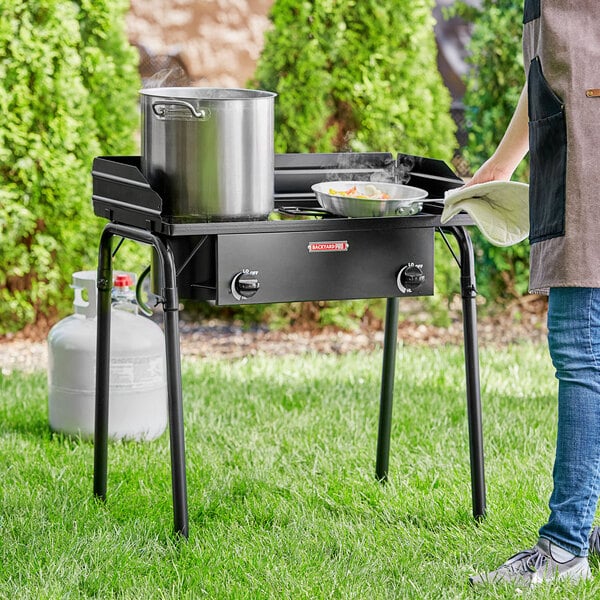
Burner: A model with a larger burner will let you utilize larger cookware. Higher BTU ratings mean that your stove will reach temperature faster.
Height and stability: These start at less than 10" high and can be over 20" high. A taller model will make it easier to lift heavy stockpots, but this added height also makes it easier to knock over accidentally. Square stoves are also generally more stable than round ones.
Production: Low volume, good for small gatherings such as company picnics or tailgating events.
Fuel: Propane
Other features: Hose and wind guards are excellent additions that improve stove safety. A hose guard prevents damage to the hose at the connection point, while a wind guard prevents the flame from wind manipulation.
Related Resources

December 2025 WebstaurantStore Coupon Code
The holiday season is here, and during December you can find amazing deals on important items here at WebstaurantStore for the upcoming season. We're offering great sales all month long, with deals ranging from essential restaurant beverage equipment to themed take-out supplies for your festive creations. Check out our selection of sale items below and don't forget to enter the code WINTER25 at checkout to enjoy savings of up to 10%! Looking to save even more? Check out the new Webstaurant Rewards® Visa Business Card ! Sign up for a new card today and start earning rewards on every WebstaurantStore purchase, and save on a WebstaurantPlus subscription. Explore incredible deals on festive disposable items with December's monthly coupon code!

Types of Charbroilers
Whether you're preparing burgers, steaks, or chicken, charbroilers are an essential part of any commercial kitchen. They provide a quick and efficient way to cook food while adding a signature smoky flavor that customers love. Charbroilers come in several different forms, and it's important to purchase the right type for your specific needs. Whether you've operated a commercial kitchen for years or are just starting to plan your kitchen's layout , we'll outline the different types of charbroilers to help you make informed purchasing decisions. Shop All Charbroilers Click any of the tips below to skip to the charbroiler information that interests you: What Is a Charbroiler? Commercial Charbroilers Charbroiler Heat Sources Charbroiler Feature
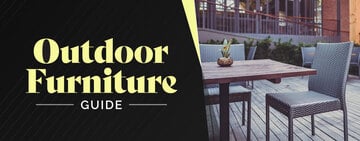
A Guide to Commercial Outdoor Furniture
Creating a lively patio area for your guests to eat or socialize in can be a profitable addition to your establishment. This is especially true for those featuring outdoor kitchens and other unique dining experiences. Whether you run a niche restaurant or a large hotel chain, customers love being able to enjoy the outdoors during their visit. Learn more about the types of outdoor restaurant furniture to use in your patio areas as well as the various accessories you can add to restaurant settings, pool settings, or simple social settings. Shop All Restaurant Patio Furniture Use the following links to learn more about commercial outdoor furniture: Commercial Patio Furniture Commercial Pool Furniture Outdoor Picnic Tables and Park Furniture Ou

